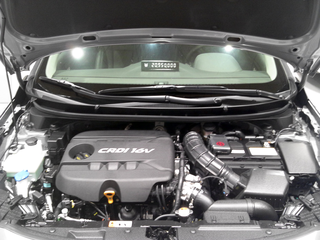
Mazda has a long history of building its own diesel engines, with the exception of a few units that were built under license.

The 6G7 series or Cyclone V6 engine is a series of V6 piston engines from Mitsubishi Motors. Five displacement variants were produced from 1986 to 2021, with both SOHC and DOHC, naturally aspirated and turbo charged layouts. While MIVEC variable valve timing has also been implemented in some versions the 2.5, 3.0 and 3.5 L versions were also available with gasoline direct injection. This engine has been the flagship powerplant of the company except when they briefly built a V8 in 1999–2001. The staple of their high-end sedans, it was given twin-turbos for the Mitsubishi GTO, and became the most powerful car ever built by the company at the time.
The Hyundai Alpha series is a multi-valve gasoline inline four-cylinder engine family comprising 1.3, 1.4, 1.5, and 1.6L naturally aspirated versions and a 1.5L turbocharged version. Introduced in 1992, this was Hyundai's first engine designed entirely in-house and was the first indigenous South Korean engine design. Design objectives were to provide high performance and good fuel economy with excellent durability at a reasonable cost.
The Hyundai Beta engines are 1.6 L to 2.0 L I4 built in Ulsan, South Korea.
The Hyundai Sirius engine was the company's first larger inline-four engine, with displacements from 1.8 L to 2.4 L. It is a license-built Mitsubishi construction. This engine is no longer used by Hyundai.

The Hyundai Delta family is the company's smaller V6 engine, ranging from 2.5 to 2.7 L. Both share the same 75 mm (2.95 in) stroke and both are DOHC designs.
The Hyundai Sigma engine is a series of V6 piston engines from Hyundai Motor Company, based on the Mitsubishi 6G7 engine. The Sigma engine family began life with the simple V6 name. Displacement ranges from 2.5 to 3.5 L.

Hyundai's Epsilon engine is a category of small Straight Inline Gasoline automobile engines.
The Omega Ω is a V8 engine produced by Hyundai Motor Company. It is a dual overhead cam design with electronic multiport fuel injection or Gasoline Direct Injection.

The Hyundai Lambda engine family is the company's modern all-aluminum V6 engine. It is currently manufactured at Hyundai's plant in Asan, South Korea. It used to be manufactured at HMMA plant in Montgomery, Alabama, United States. All versions of this engine use a timing chain.

The Hyundai Theta is a gasoline four-cylinder automobile engine family. The third all-aluminum engine of Hyundai Motor Company debuted in the fourth-generation Hyundai Sonata sedan, which was unveiled in August 2004 in South Korea. Hyundai Motor Manufacturing Alabama (HMMA) built a Theta II engine shop on the grounds of their Montgomery, Alabama automobile factory.
The Hyundai Mu engine is a variant of the 2.7 Liter Delta, the main difference with the Delta engine is the inclusion of the Continuous variable valve timing (CVVT).

Hyundai's Kappa automobile engine series consists of three-cylinder and four-cylinder models.

The Hyundai U engine is a series of three or four-cylinder diesel engines made for automotive applications by the Hyundai Kia Automotive Group. The U series of engines includes the smallest automotive diesel engines produced by Hyundai.
The Hyundai R engine is a diesel 4-cylinder automobile engine produced by Hyundai Motor Group, it was announced during the Advanced Diesel Engine Technology Symposium in November 2008 and began production in 2009.

The Hyundai Gamma engine was introduced in 2006 to replace the existing Hyundai Alpha engine. There are 1.4 L and 1.6 L versions of this engine.

The Hyundai Nu engine was introduced in the 2011 Hyundai Elantra to replace the previous Beta engines. It was designed to fill the gap between the new Gamma 1.6L and the 2.0L Theta II.

The Hyundai Smartstream is a gasoline and diesel automobile engine branding used by Hyundai since 2018. An all-aluminum engine of Hyundai Motor Company debuted in the third-generation Hyundai i30 hatchback, which was unveiled in 2018 in Paris Motor Show.
The Hyundai D engine is a family of 3-cylinder and 4-cylinder diesel engines produced by Hyundai Motor Company under license from VM Motori.










